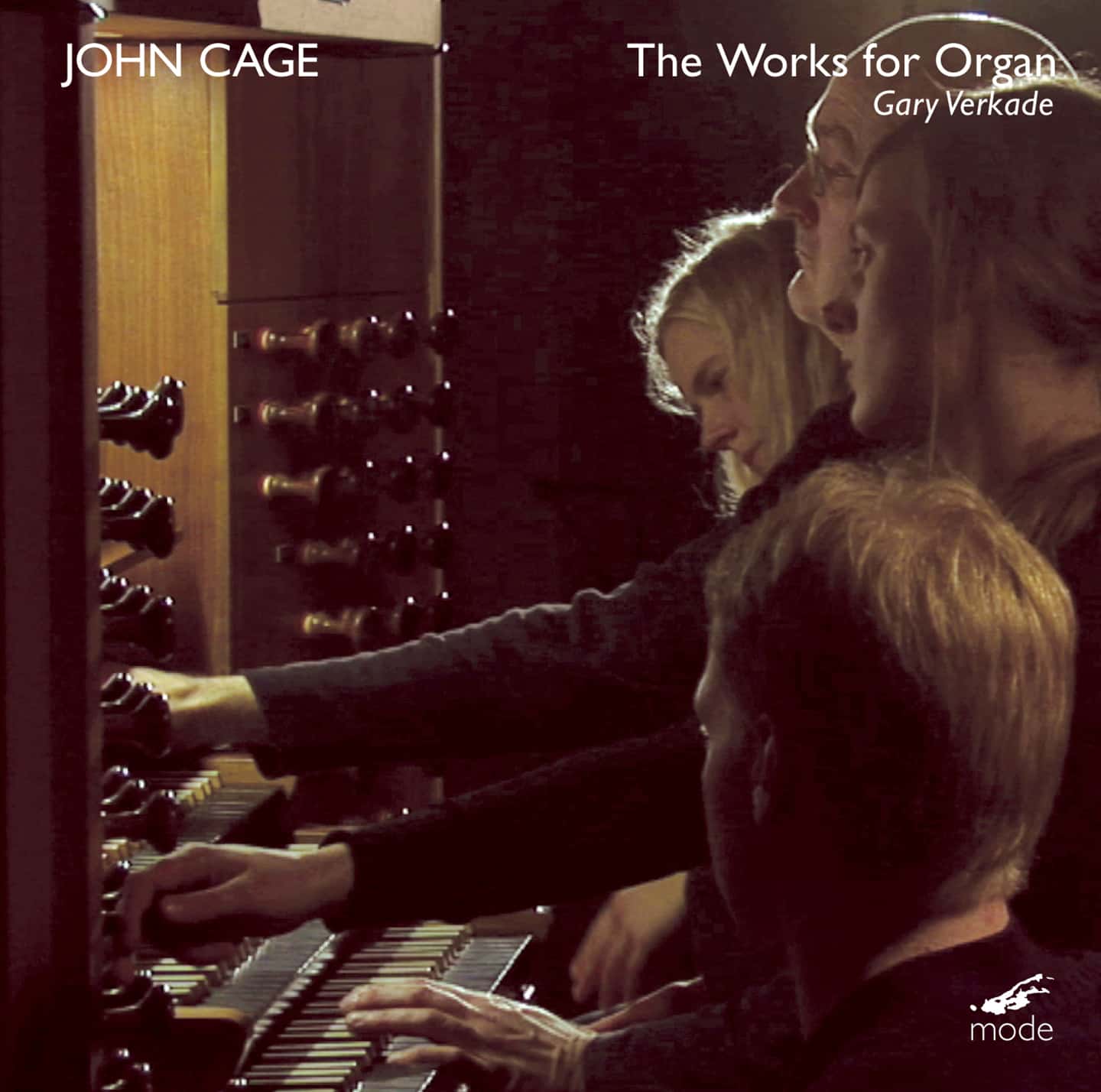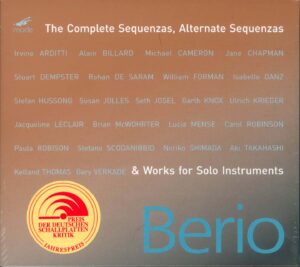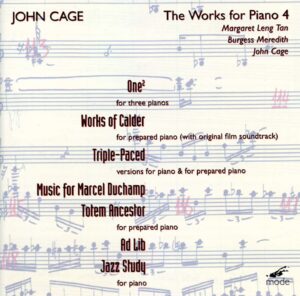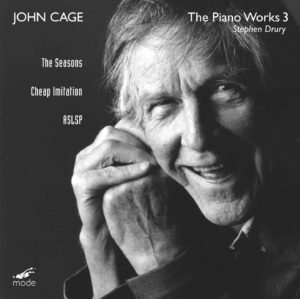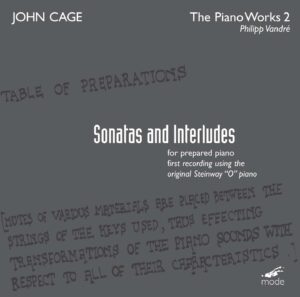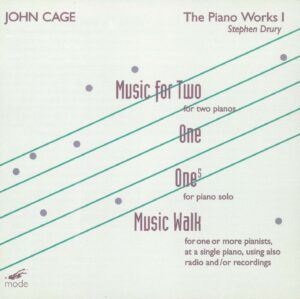Cage Edition 47-The Works for Organ - CD
The Complete John Cage Edition Volume 47
Gary Verkade, organ of Gammelstad Church, Sweden
Some of “The Harmony of Maine” (Supply Belcher)(1978) 41:33
Souvenir (1983) 6:50
ASLSP (1985) 23:02
Organ2/ASLSP (1987) 32:56
Bonus Track on DVD only:
4’33” (1952) 6:16
This release is the first complete recording of all of Cage’s works for organ, plus 4’33” (on the DVD version only).
The organ is ideally suited to Cage’s aesthetic — its multitude of stops make it the ultimate “prepared” instrument. The fact that sound emanates from a number of pipes placed at discrete locations in space nicely accords with Cage’s idea of the separation of sounds in space. And it represents vast possibilities that could be released as sound through the use of chance operations. For this reason Cage’s organ music occupies a small but quite important place within his output.
For Some of “The Harmony of Maine” Cage selected 18th-century American hymns by Supply Belcher and altered them by extending certain tones and removing others through chance operations so as to attenuate the functional harmony underlying them. Here and there, melodic fragments from the original hymns remain.
ASLSP and Organ2/ASLSP are wonderful explorations of sound written for the German organist Gerd Zacher, an important champion of new music.
Souvenir is an unusual work for Cage from 1984. After receiving half of the commission fee from the American Guild of Organists, he learned that they wanted him to make a piece that was similar to the 1948 piano composition Dream. Never one to repeat himself literally, he returned the commission fee, but it was remailed to him with assurances that he could make whatever kind of piece he wished. Thus liberated, he decided to comply with the original request, and so Souvenir is a melodious work with repetitions yet with the intrusions of harsh tone clusters, which make it something “new.”
American organist Gary Verkade, a Zacher student, is on the faculty of the Musikhögskola in Piteå, Sweden. He has appeared at major festivals and concerts throughout Europe and the USA. Verkade was one of the registrants in the first German performance of Some of “The Harmony of Maine.”
The DVD allows the listener to enjoy the sounds of the spectacular organ and its acoustic in surround sound while viewing Tim Chu’s painterly films of the organist with the up to six registrants needed for some of the pieces.
Includes trilingual booklet with essay by Rob Haskins.
DVD FEATURES:
BONUS interview with Gary Verkade, discussing performing Cage on the organ, how “chance” is applied to the performances and musical examples (31 minutes).
5.1 Dolby and 24-bit DTS surround sound options plus dedicated stereo mix.
Language : English.
Reviews
5 Diapasons 
Une aubaine que cette somme des œuvres de Cage explicitement destinées à l’orgue : voici une version convaincante et documentée de ces pièces pour la plupart de circonstance. Ecrite en 1983 pour l’American Guild of Organists, Souvenir est la plus abordable du lot, se référant à une modernité devenue classique et qui avait été celle de Cage quarante ans plus tôt. ASLSP (As SLowly/Softly as Possible, 1985) et Organ2/ASLSP (1987) sont aussi des commandes : la première a connu maints enregistrements au piano, c’est son premier à l’orgue ; la seconde est dédiée à l’organiste-compositeur Gerd Zacher, qui l’a gravée. Enfin, les quatorze aphorismes en trio de Some of The Harmony of Maine (1978) témoignent des interventions d’un Cage guide par le Yi-King : non sur des écrits de Thoreau ou des oeuvres de Duchamp, mais sur des hymnes choraux extraits du recueil The Harmony of Maine (1794) de Supply Belcher (1751-1836) ; les hexagrammes donnent également la registration de chaque note, ce qui oblige à s’entourer de six assistants pour un orgue mécanique de deux claviers et trente et un jeux indéterminés.
Pour cette dernière oeuvre, la permanence des fondamentales dans la registration de Gary Verkade suggère quelque chose de trop intentionnel : déjà interventionniste, Hans-Ola Ericsson, usant de jeux désaccordés ou à demi tirés, la plaçait arbitrairement dans une famille délibérément expérimentale (Darasse, Ligeti, Berio) ; avec des tempos lents, et en dépit de la sécheresse de cet orgue de 1971, Verkade préserve quant à lui le sentiment d’une ossature harmonique préexistante, vestige sous-jacent du substrat hymnique. Pour les ASLSP, oùle temps joue un rôle essentiel, Verkade propose une solution equilibrée, assez proche de son maître Zacher. Et ce n’est pas son moindre mérite, enfin, que de nous persuader de la valeur de Souvenir, don’t il sait dégager la poésie intense et mystérieuse.
— Paul de Louit, Diapason
John CAGE (1912-92)
11le Works for Organ
Souvenir ( 1984) (6:50)
Some of “The Harmony of Maine” (Supply Belcher) (1976) (41:33)
ASLSP (1985) (23:02}
Organ2/ ASLSP ( 1987) (32:56)
Gary Verkade (organ)
rec. November 2007, NederluleS Church, Gammelstad, Lulea
MODE RECORDS MODE 253/54 (48:05 + 55:41)
DVD version also includes:
4:33 (1952) (6: 16)
Discussion with Gary Verkade (31:00)
Audio 1: 5.1 Dolby Digital Surround
Audio 2: 5.1 DTS 2-1-bit Surround
Audio 3: 2:0 Dolby Stereo
MODE RECORDS MODE 253 (144:00)
This is volume 47 of the Mode label’s Complete John Cage Edition, a clearly magnificent project which has I am ashamed to say has passed me by almost completely until now. Cage didn’t write much music for organ, but the advantage of this is that we can have the entire oeuvre on a double disc CD or a single DVD. The CD is nicely produced, but the DVD has numerous advantages which will appeal to audio buffs, the considerable spatial qualities of the remarkable 1971 Gronlunds organ in Gammelstad being captured in fascinating surround-sound on the DVD. The quality of the instruments in Lulea has already been encountered in Hans-Oia Ericsson’s very special The Four Beasts‘ Amen (see review).
This would seem to be enough of a USP for anyone, but the complex and balletic interaction of the assistants changing stops on Organ2/ASLSP and other works makes this one of the most visually appealing organ videos you’re likely to find anywhere – short of one of those spectacular productions which have cameras racing up and down the pipes and flying over landscapes in efforts to compensate for the static nature of the instrument. Paul Serotsky goes into some length on the conceptual ins and outs of Organ2/ASLSP in what in fact is a spoof review from one of those historic April Fool lists, but which does throw up some interesting views and issues. The “mechanics of going ‘as slowly as possible’ can of course be taken to ridiculous extremes, ” Yet, Cage wrote a piece of music …” with the resulting associated problems laid out extensively, I would counter this by positing that Cage might also have considered his composition a piece of art, at which point all of the stresses of relating an ‘endless’ piece of music to our usual expectations fall away. Whew. By accepting a definition of music as ‘organised sound’ and having a requirement of a certain quality of character and recognisability within its sonic parameters as a work of art in sound then it’s ‘up, up and away to infinity’ as far as performance duration is concerned. If you substitute your eyes for your ears, then all conceptual and almost all practical arguments on this subject are dissolved.
In any case, the intriguing nature of the piece played in a reasonably practical span of just over half an hour means that it is no harder to consume than, say, one of Messiaen’s cycles. The musical content is by no means as static as you might expect either, with fascinating contrasts of colour and texture to go along with the remarkable and sometimes chilling effects of stops half opened or being squeezed shut slowly, with the resultant deflating bagpipe effects also beloved of Gyorgy Ligeti, Keith Jarrett and Tilo Medek. I’ve had a look at the score and I’m not sure how much of this is down to the interpreters – it doesn’t seem to be one of Cage’s performance requirements, but I love the sound anyway so who cares. These effects and the ways they are achieved are explained at length by Gary Verkade in his talk at the end of the DVD.
some of “The Harmony of Maine” (Supply Belcher) is a sequence of 13 movements which refer to 18th century psalm tunes, something he was occupied with at the time. Cage’s treatments remove some notes and extend others as well as adapting the meter of Belcher’s music, but the more apparent element of this confluence of the ancient and the modern are the hymn-like ham1onies which frequently pop out, taking our expectations of angular melody and dissonance by surprise. There is some more visual relief in this piece from the DVD, with interior views of the church and some of its art works. This is a sequence of pieces which will either draw you in and fascinate through its filtering of the old into new vessels, or will drive you up the wall with its constant return to fundamental harmonic intervals which are never allowed to develop conventionally. As ever with Cage, it is up to us to ditch our pre-programmed expectations, and allow his uncompromisingly purposeful and consistent language to take us on its own journey.
By comparison with the previous monumental pieces, Souvenir is like finding an extra sweet in your bag when you thought you’d finished them. It harks back to forms found in some of Cage’s earlier piano pieces, and with nicely shaped melodic phrases and only mildly gruff interjections of low clusters, this smaller work has at times an almost medieval, even meditative feel.
ASLSP was originally written for piano, and has a more restrained feel than Organ2/ASLSP, lacking the pedal part, though comparable effects arise from those shifting stops. Watching 4:33 feels almost as silly as performing it, and seeing the track lasts 6:16 also made me chuckle. This is something everyone should however do at home now and again. Stop and hear the concert going on around and within you all the time.
Gary Verkade’s little talk on the DVD has some nice personal anecdotes and is highly enlightening on the music in this recording, another very good reason for choosing the DVD over the CD version of this release.
Of the competition in this field this version comes out pretty much on top, and certainly beats all comers when it comes to completeness. Gerd Zacher’s 29:25 performance of Organ2/ASLSP is available as a download and is one of those real bargains if you are after a superb duration per penny ratio. Zacher’s instrument is however set in a rather dry acoustic, and I don’t prefer it to Verkade’s. There’s a recording of Souvenir on the New Albion label, NA074CD, with organist Christoph Maria Moossmann emphasising the mysterious and stretching the piece to 10:55 on an instrument which also seems to be being encouraged to manufacture microtones to a far greater extent in Verkade’s – that or it’s just horrendously out of tune. With the remarkable instrument at Gary Verkade’s disposal I can’t imagine these recordings being bettered any time soon, whatever your opinion on some or all of the music.
— Dominy Clements, musicweb-international, July 2013

Was haben Franz Schubert und John Cage gemeinsam? – Der Dreiklang Dur bleibt nicht fröhlich, sondern wird melancholisch. Diesen unbeschreiblichen Ton trifft die Einspielung von Gary Verkade mit Werken von John Cage. Gerade die scheinbar naiv angelegten Stücke Souvenir (1984) und Some of „The Harmony of Maine“ (1976) auf der ersten CD zeigen eine „heitere Traurigkeit“, die der aus Chicago stammende und heute im nordschwedischen Piteå lehrende US-Amerikaner Verkade treffsicher wiederzugeben weiß.
Die zweite CD enthält das in letzter Zeit durch das Projekt in Halberstadt zusätzlich bekannt gewordene Organ2/ASLSP (as slow as possible), das dort unabhängig von der von Cage intendierten Fassung in 639 Jahren aufgeführt wird. Ursprünglich ist die Komposition für Klavier oder Orgel komponiert. So ist die Kombination mit der Klavierfassung ASLSP von 1985, die hier auf der Orgel gespielt wird, schlüssig. 1987 schrieb Cage eine Orgelfassung für Gerd Zacher. Die gewählte Dauer von einer guten halben Stunde entspricht einem langsam durchschrittenen Augenmaß der Partitur. Im Vergleich zur einstündigen Fassung von Hans-Ola Ericsson und Christoph Bossert, die langsamer und romantischer ist, besticht die vorliegende Einspielung durch große Selbstverständlichkeit und Authentizität. Sicher ist die halbstündige Fassung näher an der ursprünglichen Intention Cages, die auf ein langsames, quasi unendliches Fließen der Zeit abhebt, die subjektiv (und nicht wie in Halberstadt quasi objektiv) zu erleben sein soll. Es ist aber noch mehr, was die CD zu bieten hat, es ist der Tonfall, der stimmt. Die Komposition erreicht unter Verkade eine kraftvolle Dichte und Spannung, die konträr zur auskomponierten Langsamkeit einen hochmusikalischen Bogen zu schlagen vermag. Die qualitativ hochwertige Aufnahme hätte dabei gewiss ein etwas weniger lieblos gestaltetes Booklet, zudem mit unterbelichteten Fotos, verdient.
—Dominik Susteck, Organ – Journal für die Orgel, March 2013

